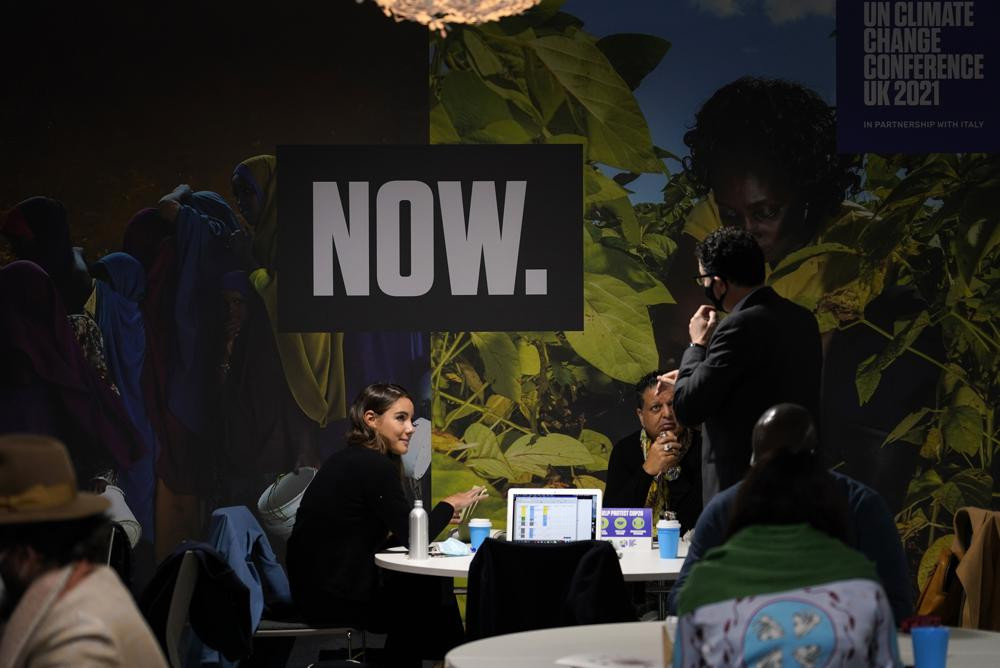The princes, presidents and prime ministers have left, and now the real mask-to-mask climate negotiations start.
For the next 10 days, maybe more, the professional diplomats at the crowded United Nations climate conference must convert marching orders left by their heads of government into compromises and agreements. The talks happen in a limited number of meeting rooms in Glasgow, with a Friday, Nov. 12, deadline and a record long agenda listing 104 items that must be settled.
The negotiations are restricted by the pandemic but aided by a year and a half of virtual meetings, instant soup brought from Norway and chocolates from Swiss and Australian diplomats.
By next week, the deadline pressure is sure to intensify. Meetings will go around the clock. Food and sleep will be put aside, except when someone dozes off in a seat or on a colleague’s shoulder.
“We have meals together and spend hours cooped up in conference centers with little sleep and bad food. It is a bit of a mad bonding experience, but it builds trust. And trust is key to compromise,” said Environmental Defense Fund Vice President Kelley Kizzier, who spent 15 years as a European Union negotiator.
At least 120 meetings were scheduled for Wednesday, with more likely to be added. But only 25 meeting rooms are available in the sprawling conference complex where half of the structures are temporary, with makeshift roofs and rows of spotless but chilly portable toilets. And those rooms permit a limited number of people inside because of social-distancing rules designed to keep everyone 1.5 meters (4.9 feet) apart.
Between meetings, everyone has to get out for 15 minutes of cleaning, something the Scottish government insists on, said Laura Lopez, the conference administrator for the United Nations Framework Convention for Climate Change, which runs the negotiations on a site that is technically U.N. property.
“The problem is our people aren’t that disciplined,” Lopez said. “They keep talking and won’t leave the room.”
The rooms where it happens are often the rooms next to where it happens.
“The deals are made very often outside of the room,” said longtime negotiator Yamide Dagnet, now head of negotiations for the World Resources Institute. Countries give their positions at the table, but it is in the hallways, during coffee breaks, snatches of meals and other away time that compromises emerge, she said.
That’s why in-person meetings can’t be replaced by virtual ones, said veteran negotiator Tosi Mpanu Mpanu, who chairs one of the two main negotiating groups for the U.N.
“In the hallway, you meet someone, and that’s where you agree on that comma versus that semicolon, and that’s what’s missing” in virtual meetings, he said.
The 18 months of virtual negotiations have brought people closer and made them work together more. But they need to seal the deal in person, said Mpanu Mpanu and Marianne Karlsen, who heads another negotiating group for the U.N.
“People need to sit eye-to-eye,” Karlsen said.
They both credit the pandemic and the months of virtual meetings for improvements over previous meetings.
“I really think the pandemic brought an extra deal of flexibility,” Mpanu Mpanu said.
In past years, the U.N. would put beanbag chairs in meeting rooms and offices for catnaps during the final crunch, Lopez said. But the pandemic killed that this year.
Karlsen said one key to survival is having a supply of snacks, chips, chocolate and fruit — as well her personal contribution.
“I always bring extra luggage with instant soups,” Karlsen said. The Australians and Swiss finance negotiating teams are well known for bringing chocolate.
“And there’s no strings attached,” Mpanu Mpanu said.
When talks go late and people get tired, bigger, richer countries that have extra negotiators have a leg up on smaller nations, he said.
“If you are not on top of your game, people will take advantage of that,” Mpanu Mpanu said.
In the past, negotiators were often joined in the rooms by observers, often from nonprofits. But the talks are now closed to those groups and to the media.
Because of the virus, the U.N. climate office has tried to offer more remote meeting access. With several poorer island nations unable to send negotiators and room occupancy severely limited by health rules, the remote system is crucial, but it has been filled with glitches.
Observers and activists have complained that they can’t get into meetings or watch them online.
The United Kingdom’s largest-ever diplomatic event had the U.N. apologizing for the video glitches, the lack of disability accessibility for an Israeli cabinet member, and for long, slow security lines.
The security lines were slow because 25,000 people have picked up passes. But at any given time, only 10,000 people can be present because of the pandemic, and the lines must be wider and fewer for social distancing, Lopez said. The conference briefly had to stop allowing people in because of the 10,000-person limit.
But hardships are just part of the deal with negotiators, Karlsen said: “There is no easy borne children at this process.”

